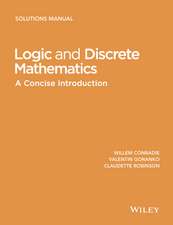Petri Nets for Systems Engineering: A Guide to Modeling, Verification, and Applications
Autor Claude Girault, Rüdiger Valken Limba Engleză Paperback – 15 dec 2010
The book covers the main phases in the life cycle of design and implementation of a system, i.e., specification, model checking techniques for verification, analysis of properties, code generation, and execution of models. These techniques and their tool support are discussed in detail including practical issues. Amongst others, fundamental concepts such as composition, abstraction, and reusability of models, model verification, and verification of properties are systematically introduced.
| Toate formatele și edițiile | Preț | Express |
|---|---|---|
| Paperback (1) | 604.72 lei 6-8 săpt. | |
| Springer Berlin, Heidelberg – 15 dec 2010 | 604.72 lei 6-8 săpt. | |
| Hardback (1) | 668.41 lei 6-8 săpt. | |
| Springer Berlin, Heidelberg – 13 noi 2002 | 668.41 lei 6-8 săpt. |
Preț: 604.72 lei
Preț vechi: 755.90 lei
-20% Nou
Puncte Express: 907
Preț estimativ în valută:
115.74€ • 120.36$ • 96.85£
115.74€ • 120.36$ • 96.85£
Carte tipărită la comandă
Livrare economică 15-29 martie
Preluare comenzi: 021 569.72.76
Specificații
ISBN-13: 9783642074479
ISBN-10: 3642074472
Pagini: 624
Ilustrații: XVI, 607 p.
Dimensiuni: 155 x 235 x 33 mm
Greutate: 0.86 kg
Ediția:Softcover reprint of hardcover 1st ed. 2003
Editura: Springer Berlin, Heidelberg
Colecția Springer
Locul publicării:Berlin, Heidelberg, Germany
ISBN-10: 3642074472
Pagini: 624
Ilustrații: XVI, 607 p.
Dimensiuni: 155 x 235 x 33 mm
Greutate: 0.86 kg
Ediția:Softcover reprint of hardcover 1st ed. 2003
Editura: Springer Berlin, Heidelberg
Colecția Springer
Locul publicării:Berlin, Heidelberg, Germany
Public țintă
Professional/practitionerCuprins
Introduction: Purpose of the Book.- 1. Introduction.- 2. Essential Features of Petri Nets.- 3. Intuitive Models.- 4. Basic Definitions.- 5. Properties.- 6. Overview of the Book.- 8. Modelling and Analysis Techniques by Example.- 9. Techniques.- 10. Methods.- 11. Case Studies.- 12. Conclusion.- 13. Introduction: Issues in Verification.- 14. State-Space-Based Methods and Model Checking.- 15. Structural Methods.- 16. Deductive and Process-Algebra-Based Methods.- 17. Conclusion.- 18. Introduction.- 19. Systems Engineering and Validation.- 20. Net Execution.- 21. Code Generation.- 22. Conclusion.- 23. Introduction.- 24. Flexible Manufacturing Systems.- 25. Workflow Systems.- 26. Telecommunications Systems.- 27. Conclusion.- References.
Recenzii
From the reviews:
"This is an extensive work providing an overview of the current state of the art of the use of Petri nets in systems engineering. … The book has been carefully written avoiding an excess of formulas and technicalities. … This book is suited for those well acquainted with formal modelling of systems and who now want to learn which techniques are available from the perspective of Petri nets." (J.F. Groote, Zentralblatt MATH, Vol. 1024, 2003)
"This is an extensive work providing an overview of the current state of the art of the use of Petri nets in systems engineering. … The book has been carefully written avoiding an excess of formulas and technicalities. … This book is suited for those well acquainted with formal modelling of systems and who now want to learn which techniques are available from the perspective of Petri nets." (J.F. Groote, Zentralblatt MATH, Vol. 1024, 2003)
Textul de pe ultima copertă
Formal methods for the specification and verification of hardware and software systems are becoming more and more important as systems increase in size and complexity. The aim of the book is to illustrate progress in formal methods, based on Petri net formalisms. It contains a collection of examples arising from different fields, such as flexible manufacturing, telecommunication and workflow management systems.
The book covers the main phases of the life cycle of design and implementation of a system, i.e., specification, model checking techniques for verification, analysis of properties, code generation, and execution of models. These techniques and their tool support are discussed in detail including practical issues. Amongst others, fundamental concepts such as composition, abstraction, and reusability of models, model verification, and verification of properties are systematically introduced.
The book covers the main phases of the life cycle of design and implementation of a system, i.e., specification, model checking techniques for verification, analysis of properties, code generation, and execution of models. These techniques and their tool support are discussed in detail including practical issues. Amongst others, fundamental concepts such as composition, abstraction, and reusability of models, model verification, and verification of properties are systematically introduced.
Caracteristici
Offers both practical and theoretical foundations for the use of Petri nets in complex system engineering tasks Bridges the gap between Petri nets and the systems modeling and implementation process


















